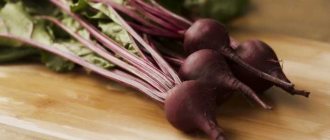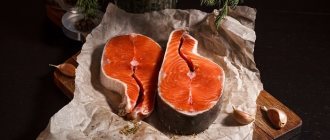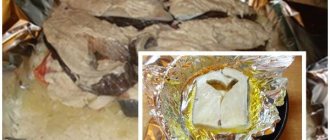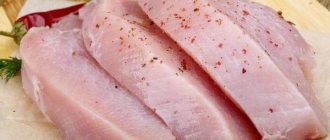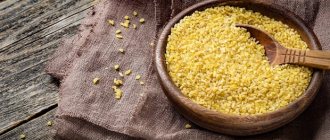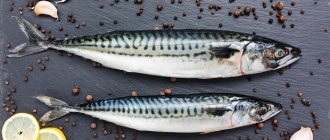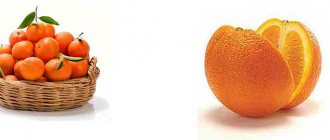Pumpkin enjoys well-deserved popularity on all continents. They cook it in different ways: boil it, bake it, stew it, eat it raw, prepare snacks, season it with spices, herbs, butter and honey. It is useful in any form for adults and children.
Of course, the maximum benefit can be obtained from the raw pulp, but the cooked vegetable also contains the same minerals and vitamins. In this article we will talk about the benefits and harms of boiled pumpkin, consumption rates and contraindications.
Raw pumpkin calories
When planning your daily diet, it is important to understand how many calories this orange vegetable contains. In fact, there are very few of them. This is why pumpkin fits perfectly into the dietary framework. There are only 22 kcal per 100 grams of pulp.
The green winter squash variety is different from its orange counterpart. It contains 40 kcal per 100 g.
As for the nutritional value, the same volume of raw pumpkin without peel yields:
- proteins - 1 g;
- fats - 0.1 g;
- carbohydrates - 4.4 g.
ABC RECOMMENDS
7 best foods for clean and healthy blood vessels
Steamed pumpkin for weight loss
Steamed pumpkin is included in the diet menu. It contains virtually no fat, but is rich in proteins and carbohydrates, making it easily and quickly digestible, creating a feeling of fullness.
Weight loss occurs due to plant fiber, which activates the gastrointestinal tract, metabolic processes, cleanses the digestive tract, and removes excess fluid.
A one-day fasting day involves eating 1 kg of steamed fruit pulp per day in small portions. This diet is considered strict, so nutritionists advise holding a fasting day no more than once every two weeks.
Advice ! After completing the fasting day, it is necessary to limit the consumption of salty foods to prevent fluid retention in the body.
The long-term pumpkin diet is considered easy, as it provides the opportunity to use a varied menu. Vegetables, fruits, berries, fish and seafood, lean meats, eggs, poultry, cheeses and cottage cheese are allowed in moderation.
Calorie content of pumpkin baked in the oven
There are different recipes for cooking pumpkin. Many people prefer to bake vegetables without auxiliary ingredients in the oven. But what is the energy and nutritional value of such a dish?
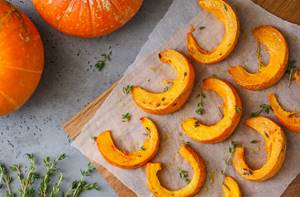
Photo source: shutterstock.com
For 100 grams of baked delicacy there is:
- proteins - 1.17 g;
- fats - 0.82 g;
- carbohydrates - 6.22 g.
At the same time, the nutritional value of such a dish is only 36.67 kcal per 100 grams. So you can eat it not only in the morning, but also for dinner. Stewed pumpkin is also a great solution. It contains only 60 kcal per 100 g. This is a wonderful healthy side dish and an excellent substitute for potatoes.
Benefits of steamed pumpkin for men and women
Pumpkin is especially useful for men of reproductive age , as it participates in the production of testosterone, the main male sex hormone. It plays an important role in the production of sperm, is responsible for mood, sexual health, libido, and affects the development of musculoskeletal tissue.

In boys, testosterone is responsible for the acquisition of male characteristics (timbre of voice, physique, male-type hair). Pumpkin on the men's menu reduces the likelihood of developing or alleviates the course of prostatitis, heart failure, and acts as an effective preventive measure for adenoma.
Steamed pumpkin is no less useful for women. It protects against genitourinary infections, helps in the treatment of gynecological diseases such as cervical erosion, inflammatory lesions, vaginitis, and infertility. During the menopausal period, the pulp of the fetus reduces the severity of symptoms of anemia, calms, and improves mood. Steamed pumpkin pulp is widely used in cosmetology and dermatology due to its antioxidant, tonic, anti-inflammatory and regenerating properties.
The usefulness of pumpkin for pregnant women , including women who are breastfeeding, lies in satisfying the body’s increased need for iron and alleviating toxicosis. Also, the vitamins and minerals in the vegetable provide normal nutrition to the embryo during intrauterine development, which is important for the normal formation of the fetus.
For children

It is difficult to overestimate the benefits of pumpkin for a young, growing organism. Properly grown vegetables without the use of nitrates ensure the physiological processes of growth and development of the child.
Even after heat treatment, the product retains large amounts of calcium and potassium, which are necessary for building bone tissue, teeth formation, coagulation processes, muscle contractions, and transmission of nerve impulses.
Iron deficiency anemia is often observed in newborns. Regular use of the product minimizes the risk of developing pathology, satisfies the body's needs for microelements, and normalizes hemoglobin levels.
The usefulness of steamed pumpkin lies in its beneficial effect on the central nervous system: children become calmer, not capricious, attentive, sleep well, perceive, analyze and reproduce information better.
Composition and nutritional value of pumpkin
All beneficial properties are explained by the nutritional value and chemical composition of pumpkin. The benefits of pulp without rind are unique. The composition contains various valuable vitamins and microelements.

Photo source: shutterstock.com
100 grams of fresh pulp contains:
- vitamin PP - 0.5 mg;
- calcium - 25 mg;
- chlorine - 19 mg;
- ascorbic acid - 8 mg;
- ash - 0.6 g;
- vitamin B9 - 14 mcg;
- phosphorus - 25 mg;
- organic acids - 0.1 g.
Also, the benefits of raw, frozen, steamed, baked in the microwave or oven pumpkin for the human stomach are explained by the presence in its composition of iron, B-group vitamins, starch, sulfur, choline, potassium, dietary fiber, cobalt, magnesium, zinc, iodine, beta carotene, sodium, vitamins A and E.
How to cook and how to use
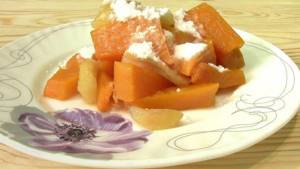
You can cook boiled pumpkin in a saucepan, double boiler, slow cooker, or microwave.
To make the vegetable tasty and retain maximum nutrients, use our tips:
- Wash the fruit with warm water, cut into pieces, remove the bark and remove the fibrous core with seeds. Do not throw away the seeds, but dry them. They contain no less useful substances than the pulp.
- Cut the pulp into pieces and cook in plain water, milk or mix them in equal proportions.
- To maintain its shape, generously brush with butter.
- Salt and bring the water to a boil before adding the pulp. In cold water, the pumpkin takes longer to cook and becomes very soft.
- The ratio of liquid to vegetable is 2:1, otherwise the product will cook unevenly.
- Check doneness with a fork or knife. If the flesh is easily pierced, it is ready.
- At the end of cooking, place the pumpkin in a colander. Do not leave in water under any circumstances if you want to preserve the vitamins and shape of the pieces.
- Add a little vegetable oil to the water. This will help the flesh cook evenly.
- Cook the pumpkin covered and over medium heat.
- In a multicooker you can cook in the “Steam” or “Soup” mode. Maximum cooking time is 30 minutes.
- To prepare pumpkin for desserts, add sugar instead of salt, cinnamon, vanilla, and star anise to the water.
Cooking time:
- in a saucepan - 30 minutes;
- in a slow cooker – 35 minutes;
- in a double boiler – 30 minutes;
- in the microwave - in two stages of 10 minutes each;
- in a pressure cooker - 25 minutes.
Important ! For children, boil the pumpkin until completely softened.
Norm per day
The norm for boiled pumpkin consumption for healthy people is 500 g.
The norm for diabetics is 200-300 g per day, which must be divided into small portions.
Daily intake of pumpkin
How much pumpkin can you eat daily? To benefit your health and well-being, it is recommended to consume 700 grams of pumpkin daily. But the entire daily intake does not imply the absorption of such a volume in 1 approach. It is proposed to divide the specified amount into 2-3 doses.
ABC RECOMMENDS

Without salmon and avocado: how to replace expensive foods on a diet
Tips and tricks
There are general recommendations on how to choose and consume pumpkin correctly to avoid unwanted consequences:
- You can determine the ripeness of a pumpkin by its tail: it should be dry and dark;
- A high-quality vegetable has thick, smooth and undamaged skin, the seeds are intact, without any foreign odor;
- the most useful are fruits with bright pulp, since they contain the largest amount of carotene;
- pumpkin is well stored, it can be eaten all winter: cut the peeled fruit into small pieces, rinse under water, using a colander to remove excess liquid, dry, put in plastic containers or tight zip-lock bags. Store at a temperature of 18-23 degrees;
- the average daily intake of steamed pumpkin for an adult is 300-400 g, for children 150-250 g. If there is an excess of vegetables in the body, nausea, vomiting, exacerbation of diarrhea, and the development of complications from the gastrointestinal tract are possible;
- Before use, make sure there are no contraindications.
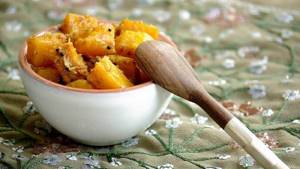
And the most important piece of advice is that pumpkin is not a panacea for all diseases. More often it is considered as a preventive measure or an adjuvant in the treatment of diseases of the digestive, genitourinary, and cardiovascular systems.
It facilitates the course of the pathology, allows you to achieve positive dynamics in a shorter time, and prevent new relapses, but if used incorrectly, it can cause harm to the body. Therefore, the question of the advisability of using steamed pumpkin as a medicinal raw material should be discussed with your doctor.
The benefits and harms of pumpkin
Why is it recommended to include pumpkin in your diet? The product has a lot of advantages. Among the beneficial properties of pumpkin it is worth noting:
- prevention of anemia and atherosclerosis;
- beneficial effects on the kidneys and liver;
- normalization of pressure;
- regulation of digestion;
- removal of edema;
- reduction of bad cholesterol;
- removal of waste and toxins.
This product also has a delicate diuretic and antiemetic effect. That is why it is so useful for pregnant women to use. The vegetable also has a healing effect on the skin. Suitable for preventive and dietary nutrition. Pumpkin dishes are good for heart disease, hepatitis and cholecystitis. With their help, you can lose weight and get rid of excess volume by removing excess moisture from tissues.
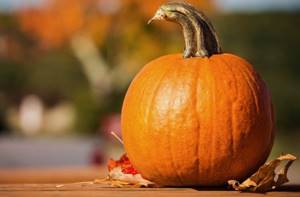
Photo source: shutterstock.com
But not only benefits can be obtained from eating pumpkin. Sometimes even such healthy food can be harmful if there are contraindications to its consumption. It is best to avoid raw pumpkin if:
- inflammation of the gastrointestinal tract;
- serious intestinal pathologies;
- gallstones;
- neoplasms in the kidneys.
The product has a choleretic effect, and therefore can provoke the movement of stones in the ducts.
In its raw form, the vegetable takes a long time and is difficult to digest. Therefore, it should not be included in the diet of elderly people and young children. Due to the high glycemic index, it is not recommended to consume the vegetable for people with diabetes. In diabetics, this product may cause an increase in blood levels.
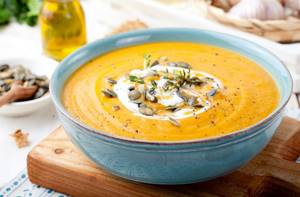
Photo source: shutterstock.com
Among other side effects, it is worth noting the ability of pumpkin (both raw, boiled or baked) to have a laxative effect. It often provokes bloating, loose stools, and diarrhea. Therefore, you should not actively lean on dishes with pumpkin, especially on an empty stomach.
In some cases (although very rarely!) Individual intolerance and allergy to pumpkin occurs.
Beneficial properties for various diseases
Traditional medicine recommends consuming steamed fruit pulp for the treatment and prevention of diseases such as:
- gout - reduces the concentration of uric acid, restores the regulation of purine metabolism, suppresses inflammation, relieves puffiness and swelling, reduces the severity of pain;
- atherosclerosis - improves the condition of vascular walls, prevents the proliferation of fibrous fibers, hemodynamic disorders, saturates the body with microelements necessary for normal heart function;
- nervous disorders - has a calming, sedative effect on the body, improves night sleep, eliminates irritability, causeless anxiety;
- obesity - improves digestion, speeds up metabolism, creates a feeling of fullness, has a laxative effect;
- renal/liver failure - restores intracellular metabolism, prevents fatty degeneration of cells, the development of liver cirrhosis, stimulates protein synthesis and normalizes energy metabolism of hepatocytes, reduces cholesterol levels in the blood, promotes its excretion along with bile;
- diseases of the digestive tract and pancreas (pancreatitis) - restores and supports the mucous membrane of the stomach, duodenum, improves the functioning of the gastrointestinal tract, activates metabolism, has a regenerating effect;
- urological diseases - removes salt stones in the kidneys, supports the functionality of the prostate, minimizes the risk of erectile dysfunction, early ejaculation, prevents the penetration of infections that cause inflammation of the upper parts of the genitourinary system (pyelonephritis, cystitis).
Steamed pumpkin is useful for people who often suffer from acute respiratory viral infections, acute respiratory infections, and colds. The vegetable stimulates the immune system, replenishes the deficiency of vitamins, minerals, micro- and macronutrients necessary to maintain natural homeostasis.
Reference ! In cosmetology, boiled and baked pumpkin is used to prepare masks. This product improves the condition and color of the skin, eliminates inflammation and rashes, tones, nourishes and moisturizes, smoothes out fine wrinkles.
Contraindications
It is contraindicated to consume steamed pumpkin in the following cases:
- individual intolerance;
- exacerbation of stomach and duodenal ulcers;
- urolithiasis in the acute period;
- diarrhea;
- diabetes.
According to the WHO complementary feeding table, pumpkin in any form is prohibited for children under eight months of age.
Pumpkin calorie table
When losing weight or as part of creating a diet for proper nutrition, a table that shows the energy value of different pumpkin dishes will be very useful and clear:
| Name of the dish | Calorie content (kcal) |
| Roasted pumpkin | 76 |
| Pumpkin puree | 88 |
| Butternut | 45 |
| Pumpkin stew | 53 |
| Steamed pumpkin | 30,5 |
| pumpkin juice | 38 |
| Pumpkin sauce | 88 |
| Pumpkin soup | 88 |
| Pumpkin boiled in water | 26 |
| Pumpkin porridge with milk | 87 |
| Pumpkin stewed in sour cream | 188,9 |
| Baked pumpkin with honey | 73,8 |
| Dried pumpkin | 181 |
You can learn how to lose weight with pumpkin from the video:
Benefits for weight loss
For weight loss and cleansing the body, pumpkin is an indispensable product. Girls in pursuit of a slim figure choose a variety of methods, and pumpkin diets are no exception. However, the best diet is proper nutrition. Only a properly structured diet and physical activity will help achieve good results.
If you decide to use pumpkin in your diet at the weight loss stage, give preference to dishes made from fresh vegetables. For example, fresh salads and cold cream soups are great options. Pumpkin cocktails and smoothies will be a good source of vitamins after a workout, so take pre-prepared fresh juice with you. In addition to pumpkin, choose your favorite fruits and vegetables.
We have already mentioned earlier that pumpkin has a beneficial effect on the intestines, therefore, at the stage of weight loss, the vegetable is used as a cleansing component, taken on an empty stomach.
The main thing is to remember that with the pumpkin diet you can only drink green tea, pumpkin juice and still water.

© M.studio – stock.adobe.com
If you cannot give up coffee, drink the drink no more than once a day. It is recommended to drink coffee, like tea, without sugar.
But how do you take pumpkin for weight loss? There are a few rules to remember:
- Every day you need to drink a glass (200 ml) of pumpkin juice on an empty stomach, preferably 20 minutes before meals;
- drink a glass of water or green tea before meals throughout the day;
- exclude sweet fruits from the diet during the diet;
- if you feel hungry, eat pumpkin - a few pieces will be enough;
- You can't eat after six in the evening.
For main dishes, choose cereals, such as buckwheat. You should also eat several pieces of vegetables at each meal. As an alternative to the usual dishes, pumpkin soups, stews, etc. are suitable.
The pumpkin diet gives good results, the main thing is to stick to the regime.
Classic recipe
Classic oven-baked pumpkin is the simplest recipe. Its calorie content is low due to the absence of oil, sugar and other additives.
Composition of ingredients
To prepare the dish you need:
- fresh pumpkin – 1 pc.;
- water (volume depends on the number of servings);
- clay pots.
Step-by-step cooking process
To make the dish tasty, you must strictly follow the cooking instructions:
- Before cooking, the vegetable must be washed and cut into 2 halves. The seeds in the cut halves should be removed with a tablespoon.
- You definitely need to cut off the crust of the pumpkin. It is removed with a knife or hand peeler. You should clean it carefully, as the crust is very dense and slippery.
- After peeling, the vegetable must be cut into small pieces or slices. The size of the pieces affects the quality of cooking. Slices or cubes that are too large may not bake well, which will affect the taste.
- Next you need to prepare the pots. Before use, the dishes should be washed and dried with a napkin. It is recommended to place vegetables in pots up to the top with a slide. For 4 servings you will need 1 kg of pumpkin. The pots need to be filled with 50 ml of water.
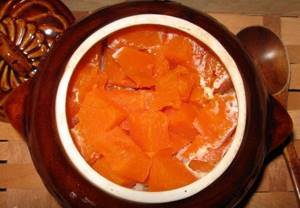
- The pots with the contents should be covered with a lid and placed on a baking sheet so that they stand stable. Next you need to put the pots in the oven. It is recommended to bake at 180°C for 1 hour. The duration of heat treatment may vary depending on the size of the pieces or the quality of the pumpkin.
- At the end of the hour, the dish must be removed from the oven and then checked for readiness. The product is considered fully baked if the inserted tines of a fork easily penetrate the pulp. If you feel that the pieces are still a little hard, put the pots in the oven for a few more minutes.
What can I add?
Sugar can be added to taste. At the end of cooking, you can add honey instead of sugar. You shouldn't add it right away. During heat treatment, honey loses trace elements and vitamins. You don't have to add anything to the dish. In this case, the pumpkin will taste bland.
How to serve a dish
It is advisable to serve the dish on the table in a beautiful plate, pouring honey over the pieces. Can be consumed both warm and cold. A dish with honey has a pleasant sweet taste, so it is suitable as a dessert for tea.
An unusual culinary perspective
Many people are accustomed to using baked pumpkin to make desserts. We invite you to make a complete dish with meat. And the pumpkin will play the role of a pot. As a result, you will get a colorful side dish with a rich taste and a meat treat.
On a note! To reduce the calorie content of this dish as much as possible, you can use chicken breast for cooking.

Ingredients:
- pumpkin - one piece;
- fresh frozen pork tenderloin – 600 g;
- onion - one piece;
- canned pineapple pulp – 400 g;
- sweet bell pepper – three pieces;
- refined vegetable oil – 50 ml.
Preparation:
- We thoroughly wash the outside of the pumpkin, and then cut off the top part of it. The base of the melon must be stable.
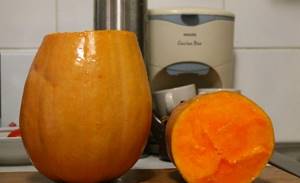
- Using a spoon, carefully scrape out the seeds. We grab the pulp to give the pumpkin the shape of a pot.
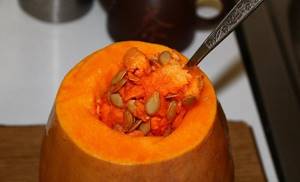
- This is how it turns out.
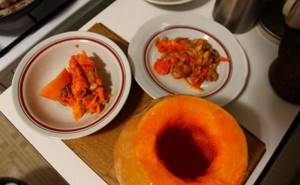
- Cut the peeled pumpkin pulp into cubes.
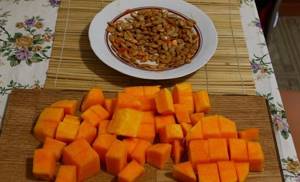
- We defrost pork tenderloin or other types of meat if necessary.

- We clean off the fat from the top, rinse and dry thoroughly with paper napkins to remove excess moisture.
- Cut the pork flesh into small pieces.
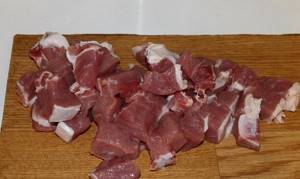
- Chop the peeled onion into small cubes.
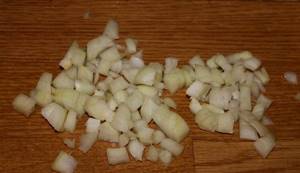
- Fry the meat with onions until golden brown.
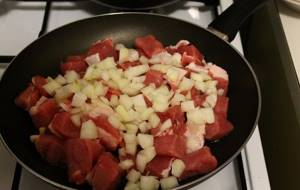
- We clean the sweet pepper from the seed box and stalk. We wash the vegetable, dry it and cut it into large cubes.
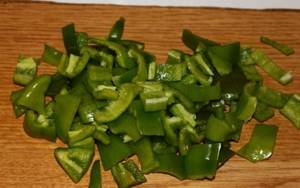
- Now transfer the chopped pepper into a thick-walled bowl.

- Add pork and onions to it.
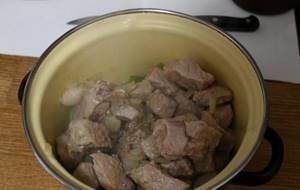
- Strain the syrup from canned pineapples. We won't need it.
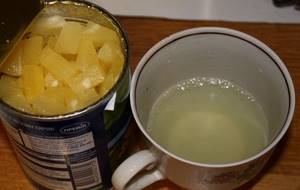
- Photo 12
- Add pineapple pulp to the above ingredients.
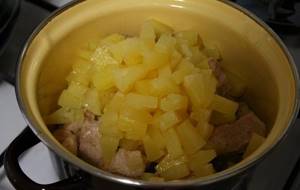
- Mix all ingredients, season with salt and place on low heat.
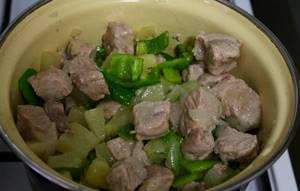
- Bring until cooked, and then transfer this filling to the pumpkin.

- Wrap the pumpkin tightly in aluminum foil and place in the oven.
- Set the temperature at 180-200°, bake for about a third of an hour.
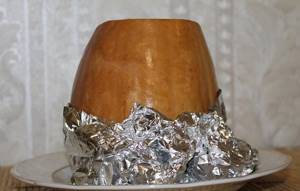
- We focus on the readiness of the pumpkin. As soon as it softens, the dish can be served. It’s better to serve it in some original way, for example, cut a circle of baked pumpkin and put meat filling in the middle.
